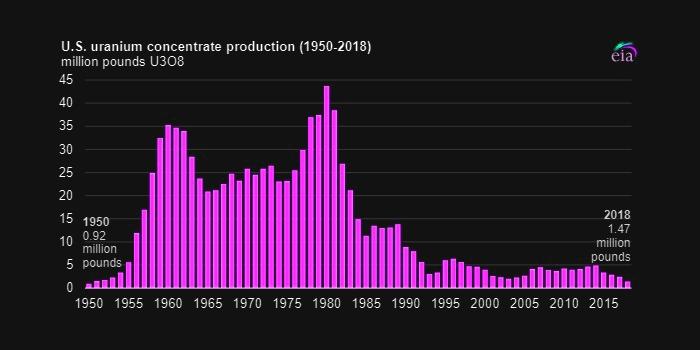
U.S. URANIUM DOWN AGAIN

U.S. EIA - The United States produced 1.47 million pounds of uranium concentrate in 2018, down for the fourth consecutive year and the lowest total since 1950, based on preliminary production data. Uranium production in the United States has declined since its peak of 43.7 million pounds in 1980 and has remained below 5 million pounds annually for more than 20 years.
As domestic uranium production has declined over the past several decades, owners and operators of commercial nuclear power plants in the United States have obtained more uranium from foreign sources. Canada has historically been the largest single source of imported uranium, followed by Australia, Russia, and Kazakhstan, countries in which the cost of uranium is lower than in the United States.
Preparing uranium for use as fuel in nuclear reactors involves several steps. The production of uranium concentrate—U3O8, known more commonly as yellowcake—is the first step in the nuclear fuel production process. In 2018, uranium concentrate was produced at seven U.S. facilities: one uranium mill in Utah and six in-situ leach plants in Wyoming and Nebraska.
In-situ leaching, or in-situ recovery, extracts uranium that coats sand and gravel particles of groundwater reservoirs. The process involves injecting a solution into the reservoir that causes the uranium to dissolve into the groundwater. This water is then pumped out of the reservoir and processed at a uranium mill. Uranium milling involves extracting uranium ore, crushing it into a fine powder, and adding chemicals to separate the uranium. Groundwater from in-situ leach operations is processed at a mill by extracting and concentrating the uranium.
EIA recently updated its U.S. Energy Mapping System to include uranium resources across the country. Uranium production facility information was also updated. The new uranium layers include
Identified resource areas, which include uranium provinces, districts, and select important deposits.
Uranium associated with phosphate, which are sedimentary phosphate deposits that contain trace amounts of uranium. When uranium prices are high enough, producers may extract trace uranium as part of the phosphate mining process.
NURE favorable areas, which are areas considered by the National Uranium Resource Evaluation (NURE) to be favorable for uranium. NURE was a U.S. Department of Energy assessment of uranium resource potential conducted from 1974 to 1982.
-----
Earlier:

2019, May, 6, 11:30:00
U.S., KAZAKHSTAN URANIUM PRODUCTION DOWN
Kazatomprom's uranium production for the first quarter of 2019 was 4% down from the same period in 2018 as the Kazakh company continues with its plan to reduce production. Meanwhile, US uranium production for the quarter was 74% down from 2018.
|

2019, April, 24, 10:35:00
SMALL NUCLEAR QUESTIONS
The race for investor commitments of cash and eventual market share among developers of small modular reactors (SMRs) globally is on. Developers in the U.S., Canada, U.K., South Korea, Russia, and China, and in other nations are pursuing their technology visions for a variety of designs concepts including light water (LWR), molten salt, HTGR, and other GEN IV types.
|

2019, April, 19, 09:20:00
U.S. NUCLEAR SECURITY
The US Department of Commerce (DOC) on 15 April submitted to the White House the results of an investigation into the effects of uranium imports on US national security. US President Donald Trump now has up to 90 days to decide whether to act on the DOC's findings and recommendations, which have not been made public.
|

2019, April, 1, 10:35:00
U.S. NUCLEAR LEADERSHIP
WNN - The Nuclear Energy Leadership Act (NELA), bipartisan draft legislation which aims to accelerate the development of advanced nuclear technologies and re-establish US leadership in nuclear energy has been re-introduced to the US Senate.
|

2019, March, 29, 11:10:00
U.S. NUCLEAR COMPETITIVENESS
Nuclear is the largest source of clean energy in the USA, and the nation's nuclear plants are working more efficiently than ever, Korsnick said, adding they are "economic engines" for the communities they serve.
|

2019, March, 22, 10:00:00
U.S. NUCLEAR WILL DOWN
Electricity generation from U.S. nuclear power plants totaled 807.1 million megawatthours (MWh) in 2018, slightly more than the previous peak of 807.0 million MWh in 2010, based on preliminary annual data. Although several nuclear power plants have closed since 2010, a combination of added capacity through uprates and shorter refueling and maintenance cycles allowed the remaining nuclear power plants to produce more electricity. In the near future, however, EIA expects that U.S. nuclear power output will decline.
|














